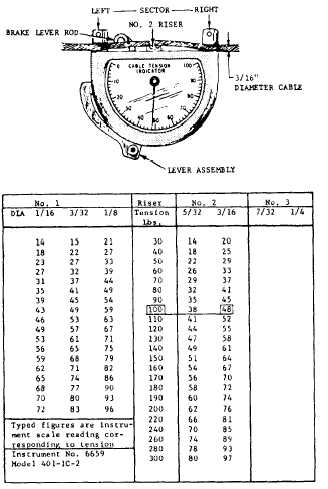CABLE AND RIGID CONTROL
SYSTEMS TROUBLESHOOTING
When the cause and remedy for a reported
malfunction in a control system are not immediately
obvious to you, it maybe necessary to troubleshoot the
system. Most aircraft MIMs provide troubleshooting
charts that list some of the more common malfunctions
in a system. Each discrepancy is accompanied by one
or more probable causes, and a remedy is prescribed for
each cause. The troubleshooting charts are organized in
a definite sequence under each possible trouble,
according to the probability of failure and ease of
investigation. To obtain maximum value from these
charts, they should be used systematically according to
the aircraft manufacturer’s recommendations.
Examples of typical troubleshooting charts and
instructions on their proper use was discussed in chapter
3 of this TRAMAN.
Since most aircraft use some form of electrical
control or hydraulic boost in their flight control systems,
maintenance of these systems must include the related
electrical circuits and hydrauIic systems. Although an
AE or AM is generally called upon to locate the correct
electrical or hydraulic troubles respectively, you should
be able to check circuits for loose connection, perform
continuity checks, and perform minor troubleshooting
of the hydraulic system.
Basically there are seven distinct steps to follow
during troubleshooting. These steps were discussed
in chapter 3 of this TRAMAN.
RIGGING AND ADJUSTING TOOLS
The purpose of rigging and adjusting a primary
flight control system is to ensure neutral alignment of
all connecting components and to regulate and limit
the surface deflection in both directions. Each
aircraft has a set of special tools for flight control
maintenance that may include rigging fixtures, pins,
blocks, throwboards and protractors. Other common
equipment, such as micrometers, pressure gauges,
push-pull gauges, feeler gauges, tensiometer and
calipers may also be required. These arc usually
maintained in the toolroom and checked out when
needed.
Tensiometer
The tensiometer is an instrument used in checking
cable tension. Tension is the amount of pulling force
applied to the cable. The amount of tension applied in
a cable linkage system is controlled by turnbuckles in
the system.
A tensiometer is a precision cable tension measuring
device, but it has limitations and can be awkward to use.
It is inaccurate for cable tension under 30 pounds. When
you take tension measurements, the instrument must not
be pressed against any part of the aircraft, it can’t be
pushed or pulled against the cable, and the cable must not
be pressed against fairleads or any part of the aircraft.
Any one of these actions may lead to inaccurate
measurements. A major advantage of cable linkage is its
minimal space requirement and the ease in which it can be
routed around, through, and behind aircraft structures and
components. This can make access difficult and the
tensiometer awkward or difficult to use.
Adequate
clearance for the tensiometer is necessary. All
tensiometers must be certified by a calibration laboratory
for accuracy at least once a month.
One type of tensiometer is shown in figure 9-23.
This instrument works on the principle of measuring
Figure 9-23.—Cable tensiometer and chart.
9-29


